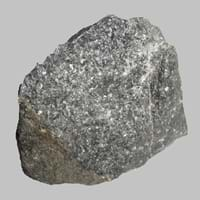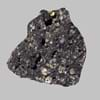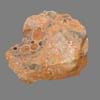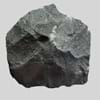Definition
Borolanite is a variety of Nepheline Syenite and belongs to igneous rocks and contains nepheline-alkali feldspar pseudomorphs which occur as conspicuous white spots in the dark rock matrix
Andesite is a dark, fine-grained, brown or greyish intermediate volcanic rock which is a commonly found in lava
Origin
Scotland
North America
Discoverer
Unknown
Unknown
Etymology
From Alkalic Igneous complex near Loch Borralan in northwest Scotland
From Andes mountains, where it is found in abundance
Class
Igneous Rocks
Igneous Rocks
Sub-Class
Durable Rock, Medium Hardness Rock
Durable Rock, Hard Rock
Other Categories
Fine Grained Rock, Opaque Rock
Fine Grained Rock, Opaque Rock
Texture
Granular
Aphanitic to Porphyritic
Color
Brown, Buff, Cream, Green, Grey, Pink, White
Bluish - Grey, Grey, Pink, Yellow
Durability
Durable
Durable
Appearance
Banded and Foilated
Dull and Soft
Interior Uses
Countertops, Decorative Aggregates, Flooring, Homes, Interior Decoration
Decorative Aggregates, Floor Tiles, Homes, Interior Decoration, Kitchens
Exterior Uses
As Building Stone, As Facing Stone, Paving Stone, Garden Decoration, Office Buildings
Office Buildings, Roof Tiles
Other Architectural Uses
Curbing
Curbing
Construction Industry
As Dimension Stone, Cement Manufacture, Construction Aggregate, for Road Aggregate, Landscaping, Making natural cement, Manufacture of Magnesium and Dolomite Refractories, Production of Glass and Ceramics
Cobblestones, Construction Aggregate, for Road Aggregate
Medical Industry
Not Yet Used
Not Yet Used
Antiquity Uses
Artifacts
Artifacts, Monuments, Sculpture, Small Figurines
Commercial Uses
Cemetery Markers
Commemorative Tablets, Creating Artwork
Types
Not Available
Icelandite
Features
Application of acids on the surface causes cloudy frosting, Available in Lots of Colors and Patterns, Dissolves in hydrochloric acid, Is one of the oldest rock
Generally rough to touch, High silica content, Is one of the oldest rock
Archaeological Significance
Famous Monuments
Data Not Available
Middle of the Earth in Ecuador
Famous Sculptures
Data Not Available
Data Not Available
Pictographs
Used
Not Used
Petroglyphs
Used
Not Used
Formation
Borolanites are formed due to alkaline igneous activities and are generally formed in thick continental crustal areas or in Cordilleran subduction zones.
Andesite is a fine-grained igneous rock that forms when the magma is erupted onto the surface and is crystallized quickly.
Mineral Content
Albite, Amphibole, Biotite, Cancrinite, Feldspar, Hornblende, Plagioclase, Pyroxene, Sodalite
Amphibole, Apatite, Biotite, Feldspar, Garnet, Hornblade, Ilmenite, Magnetite, Plagioclase, Pyroxene, Zircon
Compound Content
Aluminium Oxide, CaO, Iron(III) Oxide, FeO, Potassium Oxide, MgO, MnO, Sodium Oxide, Phosphorus Pentoxide, Silicon Dioxide, Titanium Dioxide
Silicon Dioxide
Types of Metamorphism
Regional Metamorphism
Burial Metamorphism, Cataclastic Metamorphism, Contact Metamorphism, Hydrothermal Metamorphism, Impact Metamorphism, Regional Metamorphism
Types of Weathering
Chemical Weathering, Mechanical Weathering
Biological Weathering, Chemical Weathering, Mechanical Weathering
Types of Erosion
Wind Erosion
Chemical Erosion, Coastal Erosion, Glacier Erosion
Grain Size
Fine Grained
Very fine-grained
Fracture
Conchoidal to Uneven
Uneven
Porosity
Less Porous
Less Porous
Luster
Greasy to Dull
Vitreous
Cleavage
Poor
Not Available
Toughness
Not Available
1.1
Specific Gravity
2.6
2.5-2.8
Transparency
Translucent to Opaque
Opaque
Density
2.6 g/cm3
2.11-2.36 g/cm3
Specific Heat Capacity
Not Available
Resistance
Heat Resistant, Impact Resistant, Wear Resistant
Heat Resistant, Pressure Resistant, Wear Resistant
Deposits in Eastern Continents
Asia
Indonesia, Iran, Russia, Saudi Arabia, Sri Lanka, Taiwan, Thailand, Turkey, Turkmenistan, Vietnam
India, Indonesia, Japan, Nepal, South Korea
Africa
Angola, Egypt, Madagascar, Namibia, Nigeria, South Africa
Egypt, Ethiopia, Morocco, Namibia, South Africa, Tanzania
Europe
Andorra, Finland, France, Great Britain, Italy, Norway, Portugal, Spain, Sweden
Austria, Finland, Germany, Italy, Romania, Turkey, United Kingdom
Others
Greenland
Not Yet Found
Deposits in Western Continents
North America
Canada, USA
Mexico, USA
South America
Brazil, Chile, Colombia, Uruguay, Venezuela
Argentina, Bolivia, Chile, Colombia, Ecuador, Peru, Venezuela
Deposits in Oceania Continent
Australia
New Zealand, Queensland, South Australia, Tasmania, Western Australia
New South Wales, New Zealand, Western Australia
Borolanite vs Andesite Characteristics
Though some rocks look identical, they have certain characteristics which distinguish them from others. Characteristics of rocks include texture, appearance, color, fracture, streak, hardness etc. Borolanite vs Andesite characteristics assist us to distinguish and recognize rocks. Also you can check about Properties of Borolanite and Properties of Andesite. Learn more about Borolanite vs Andesite in the next section. The interior uses of Borolanite include Countertops, Decorative aggregates, Flooring, Homes and Interior decoration whereas the interior uses of Andesite include Decorative aggregates, Floor tiles, Homes, Interior decoration and Kitchens. Due to some exceptional properties of Borolanite and Andesite, they have various applications in construction industry. The uses of Borolanite in construction industry include As dimension stone, Cement manufacture, Construction aggregate, For road aggregate, Landscaping, Making natural cement, Manufacture of magnesium and dolomite refractories, Production of glass and ceramics and that of Andesite include Cobblestones, Construction aggregate, For road aggregate.
More about Borolanite and Andesite
Here you can know more about Borolanite and Andesite. The life cycle of a rock consists of formation of rock, composition of rock and transformation of rock. The composition of Borolanite and Andesite consists of mineral content and compound content. The mineral content of Borolanite includes Albite, Amphibole, Biotite, Cancrinite, Feldspar, Hornblende, Plagioclase, Pyroxene, Sodalite and mineral content of Andesite includes Amphibole, Apatite, Biotite, Feldspar, Garnet, Hornblade, Ilmenite, Magnetite, Plagioclase, Pyroxene, Zircon. You can also check out the list of all Igneous Rocks. When we have to compare Borolanite vs Andesite, the texture, color and appearance plays an important role in determining the type of rock. Borolanite is available in brown, buff, cream, green, grey, pink, white colors whereas, Andesite is available in bluish - grey, grey, pink, yellow colors. Appearance of Borolanite is Banded and Foilated and that of Andesite is Dull and Soft. Properties of rock is another aspect for Borolanite vs Andesite. The hardness of Borolanite is 5.5-6 and that of Andesite is 7. The types of Borolanite are Not Available whereas types of Andesite are Icelandite. Streak of rock is the color of powder produced when it is dragged across an unweathered surface. The streak of Borolanite and Andesite is white. The specific heat capacity of Borolanite is Not Available and that of Andesite is 2.39 kJ/Kg K. Depending on the properties like hardness, toughness, specific heat capacity, porosity etc., rocks are resistant to heat, wear, impact, etc.Borolanite is heat resistant, impact resistant, wear resistant whereas Andesite is heat resistant, pressure resistant, wear resistant.





